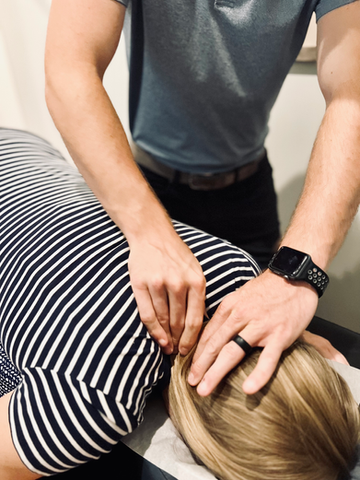
Are you experiencing headaches or migraines and looking for true correction and long-term solutions? We can help! Read more about how chiropractic can help with headaches and migraines below.
HEADACHES AND MIGRAINES
Chiropractic for Headaches and Migraines
Just about everyone, at some point in their lifetime, will experience headaches or migraines. If you’re reading this right now, chances are that you or someone you love is experiencing them. Why is it that so many will experience them? While there are certainly many factors that can contribute to or exacerbate them, our spinal health can directly contribute to the onset and frequency of headaches and migraines. Unfortunately, spinal health is often overlooked or not even considered as healthcare in the eyes of many people.
Many people who suffer from headaches turn to pain medications for relief and, while these medications can offer pain relief, they are only masking the symptoms and in no way help to tackle the true cause behind these headaches you or your loved ones are experiencing while simultaneously also putting major physiological stress on the liver and digestive system.
Chiropractic care is a safe and natural method to manage headaches. Our patients see a reduction in frequency and severity of their migraines and headaches and even full resolution with consistent chiropractic care. If you have not been prioritizing your spinal health, now is the time to start!
Tension Headaches
Tension headaches are the most common form of headaches. It’s often described as tension or pressure that feels like a band tightly wrapped around the head.
Other characteristics of tension headaches include:
-
Pain around the back of the head or neck
-
Mild to moderate pain
-
Pain that lasts for hours
-
Dull, non-throbbing pain
-
Can develop slowly
-
Typically felt on both sides of the head.
Tension headaches are caused by muscle tension and stress (which causes muscle tension). Muscles attach to bones, and the muscles in the upper back and neck attach directly to different points in the cervical vertebrae and the base of the skull. When vertebrae in the neck misalign, they can pull the attached muscles with them and can cause pain, spasm, or in this case, tension headaches. By correcting these misalignments, we can release the tension placed on these taut muscle fibers. An adjustment also signals the brain for muscle tone relaxation which can then decrease or eliminate these tension headaches.
Cluster Headaches
Cluster headaches involve bouts of excruciating pain behind an eye or a side of the head that start abruptly. They are more common in men than in women. Associating factors include smoking and family history of cluster headaches.
Cluster headaches are described as sharp, burning, or piercing and they can cause the following symptoms:
-
Pain behind an eye
-
Severe pain
-
Bouts of episodes occurring for days or weeks
-
Lacrimation
-
Runny nose
-
Redness of the eye
-
Pupil constriction
-
Sweaty face
-
Blocked nostrils
Similar to migraines, the cause behind cluster headaches is thought to be neurovascular, in which case removing interference going to the brain and vascular system can provide relief.
Migraine Headaches
Migraine headaches are a severe form of headaches. They are believed to be neurovascularly driven, which means that it’s caused by a problem in the interaction between the nervous system and the vascular system. Another influence is hormonal imbalance.
Other characteristics associated with migraine headaches include:
-
Light sensitivity
-
Sound sensitivity
-
Nausea or vomiting
-
Moderate to severe pain
-
Pain on one side of the face
-
Preceded by an aura or flashing lights, approximately 30 minutes before the episode
-
Duration of hours to days
Because this type of headache is associated with vascular changes, risk or aggravating factors can include:
-
Alcohol
-
Smoking
-
High-intensity exercise
-
Inadequate sleep
-
Diet (caffeine, chocolate, cheese, nuts, wine)
-
Dehydration
-
Emotional stress
Remember, migraines are believed to be neurovascularly driven, not muscularly driven.
When it comes to the pain felt during a migraine, it is believed that the trigeminal nerve is highly involved. The trigeminal nerve is the cranial nerve that supplies pain, temperature, pressure and other sensations to your face, scalp and blood vessels in your brain. During a migraine your threshold for pain signaling is decreased, so things that typically don’t cause pain (sneezing, bending forward, light or sound) now do.
Another mechanism that can occur is the nervous system activating pathways that constrict blood vessels in the brain, which increases arterial pressure which then causes the migraine. This is why migraines are often described as a throbbing pain.
Chiropractic care can help with migraines because it optimizes the functioning of the nervous system and, by default, the vascular system. By removing pressure off nerves, the communication between the brain and the vascular system may no longer be impeded. This increases the possibility that the trigeminal nerve fires properly and that the blood vessels in the brain can constrict and dilate as needed.






